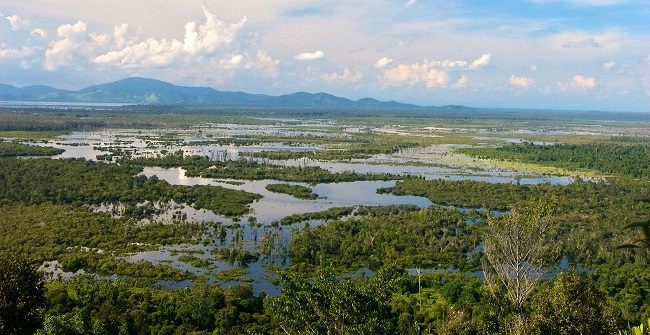A new study released on Thursday, February 13, 2025, reveals that peatlands – a vital carbon store that many people have never heard of – are dangerously under-protected, putting the global climate at risk.

Covering just 3% of Earth’s surface, these terrestrial wetlands store 600 billion tons of carbon – more than all the world’s forest biomass combined – yet only 17% of peatlands fall within a protected area.
That figure stands in contrast to the levels of protection afforded to other at-risk ecosystems, including mangroves (42%), saltmarshes (50%) and tropical forests (38%). Meanwhile, nearly one-quarter of the world’s peatlands are under heavy pressure from human encroachment, with farming the largest threat globally.
The new study, “Mismatch Between Global Importance of Peatlands and the Extent of their Protection,” which appeared on Thursday in the journal Conservation Letters, offers the first global assessment of the conservation status of the world’s peatlands. These wetlands accumulate partially decomposed organic matter, preventing the release of billions of tons of carbon dioxide (CO2) to the atmosphere. But peatlands emit that CO2 when they are drained, disturbed, extracted or removed completely to access resources (e.g., mining or forestry) or to convert them to other uses, such as farmlands.
“This study is a real benchmark of where we are in terms of the conservation and management of peatlands globally,” said Kemen Austin, Ph.D., lead study author and director of science at the Wildlife Conservation Society. “Our research reveals that these vital ecosystems don’t have anywhere near the level of protection they need.”
The authors note that release of peatlands’ stored carbon leads to dangerous levels of greenhouse gases. Failure to protect peatlands puts their carbon stores at high risk and could also endanger global supplies of freshwater, as peatlands contain 10% of the world’s unfrozen freshwater. They are also rich in biodiversity – containing a variety of mosses, flowering plants, birds, snails, fish and butterflies.
Countries with the most peatlands include Canada, Russia, Indonesia, U.S., Brazil, Democratic Republic of the Congo, China, Peru, Finland and Republic of the Congo. These 10 countries contain 80% of global peatlands. And the first five contain 70% of global peatlands.
The study reveals that at least one-quarter (27%) of global peatlands fall on Indigenous Peoples’ lands, where they have been safeguarded by these communities. Globally, the study reports that at least 1.1 million square kilometres of peatlands lie within Indigenous Peoples’ lands and that more than 85% of peatlands within Indigenous Peoples’ lands do not fall within other types of protected areas.
According to the authors, strengthening the land rights of Indigenous Peoples can confer significant benefits for the peatlands – as well as other ecosystems – they manage.
“Our study reveals a really powerful fact – that Indigenous Peoples are already important caretakers of peatlands,” said Paul Elsen, Ph.D., study author and director of conservation planning at the Wildlife Conservation Society. “This is significant because it means that we can improve peatland conservation by strengthening Indigenous People’s land rights, which is a trend that we’re already seeing in a lot of countries. So, we have to keep up those efforts.”
Peatlands under pressure
The study reveals that nearly one-quarter of peatlands are under heavy pressure from human encroachment. Some 15% of peatlands have been drained for agriculture, while an additional 5-10% are degraded in some way, including through the removal of their native vegetation. This rate is even higher in the tropics, where estimates suggest over 40% of peatlands have been degraded. In some cases, peatlands are drained and burned, emitting enormous amounts of carbon into the atmosphere. Between 1.5 and 2.5 billion tons of greenhouse gas emissions are emitted from disturbed and damaged global peatlands every year.
The study also shows that almost half of temperate and tropical peatlands that fall within protected areas are still subject to medium to high pressure from human encroachment. The authors conclude that “the conservation and sustainable management of nearly all remaining undegraded peatlands, and the recovery of nearly all degraded peatlands, is essential to limiting global warming to 1.5°C.”
Though many local communities have long known peatlands – also called bogs, fens, swamps, mires and muskeg – to be important sources of freshwater and home to diverse plant and animal species, peatlands may have gone unprotected because they are remote, difficult to access, not always easily converted to farming, mining or other industries, and have been thought of as unproductive wastelands.
“The multilateral climate change negotiations hosted by the United Nations Framework Convention on Climate Change offer an important opportunity to elevate peatland conservation actions as a climate priority,” said Austin. “But based on the nationally determined contributions countries have submitted to date, the continued disturbance and damage to global peatlands is getting very little attention as a significant and avoidable source of greenhouse gas emissions.”
With some exceptions – such as Indonesia and the UK – most countries do not have comprehensive peatland strategies to support their national climate plans.
And while some countries emphasize the importance of peatlands in their climate plans, they can still face challenges translating these peatland goals into coordinated policies and conservation actions.
“Peatlands offer a huge opportunity for helping to solve the climate crisis,” said Austin. “If we act now to conserve peatlands, then we can reap some enormous benefits – at a relatively low cost.”
